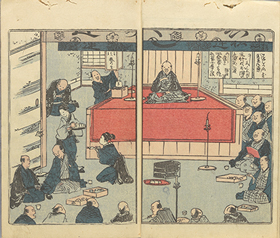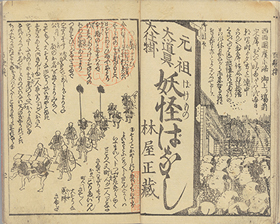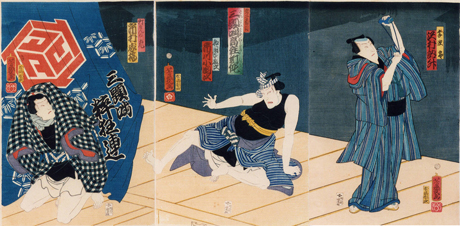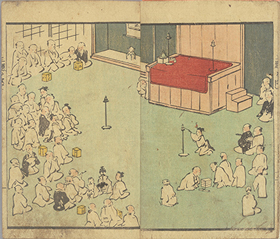Great-Edo Entertainment
Kabuki Special / Grand Sumo Special / Rakugo SpecialSandai-banashi: Impromptu Rakugo Based on Three Themes
At the start of the 19th Century, Sanshōtei Karaku I (1777-1833) introduced yose: storytelling theaters open to the public. Until then, otoshi-banashi meetings had consisted of groups of amateur enthusiasts who gathered in restaurants or rented halls on specific days to present their stories. With the advent of yose theaters, these meetings evolved into regular performances at a set location, open to the general public for an entry fee. In 1804 (Bunka 1) Karaku also introduced sandai-banashi, impromptu performances of Rakugo, to great acclaim. In these performances, his audience would propose three themes about which he would proceed to tell a single story extempore, complete with an ochi or punchline at the end. At about the same time, Karaku's pupil Hayashiya Shōzō (1781-1842) gained great popularity for his telling of ghost stories. Shōzō's performances were characterized by dramatic stage effects featuring musical effects, puppets and large props.
(Shunshoku Sandai-banashi)
Edited by Harunoya Ikuhisa, illustrated by Ikkeisai Yoshiiku.
Painted by Hayashiya Shōzō I,
illustrated by Go'untei Sadahide
1834 (Tempō 5)
At that time there were 75 yose theaters in Edo City, but this number had grown to 100 by the mid-19th Century, with storytelling by more than 200 Rakugo performers. From 1841 to 1843, however, the shogunate government executed a set of administrative reforms (generally referred to as the Tenpō Reforms) which led to the demolition of all but 24 of the theaters. Mizuno Tadakuni (1794-1851), the shogunate councilor who had promoted the Tenpō Reforms subsequently fell from power. The yose re-emerged immediately, and by the second half of the 19th Century it is said that there were over 300 venues offering performances of Rakugo or historical and military storytelling.
The sandai-banashi form of impromptu Rakugo introduced by Karaku fell out of fashion for a time, but became popular again towards the end of the Edo Period. Groups such as the Suikyōren ("eccentrics' association") and the Kyōshōren ("merriment association") held monthly performances of sandai-banashi at restaurants. "Legends of Odd Eccentrics" (Suikyō Kijin-den) was one of a number of collections of stories published by these two groups. It features the work of prominent artists of the late Edo Period and early Meiji Era: popular authors and scriptwriters such as Kawatake Mokuami (1816-1893), Kanagaki Robun (1829-1894), as well as Rakugo performers such as Sanyūtei Enchō I (1839-1900). The Rakugo work "Kajikazawa" (named after a place in present-day Yamanashi Prefecture) was originally created extempore in a sandai-banashi performance. It is regarded as a masterpiece of the genre, and is still performed today. The sandai-banashi form provided new material not only for Rakugo, but also for Kabuki drama and popular fiction, and extended considerable influence over Japanese literature of the late Edo Period and early Meiji Era.
* To view more explanation, please click the each image.





